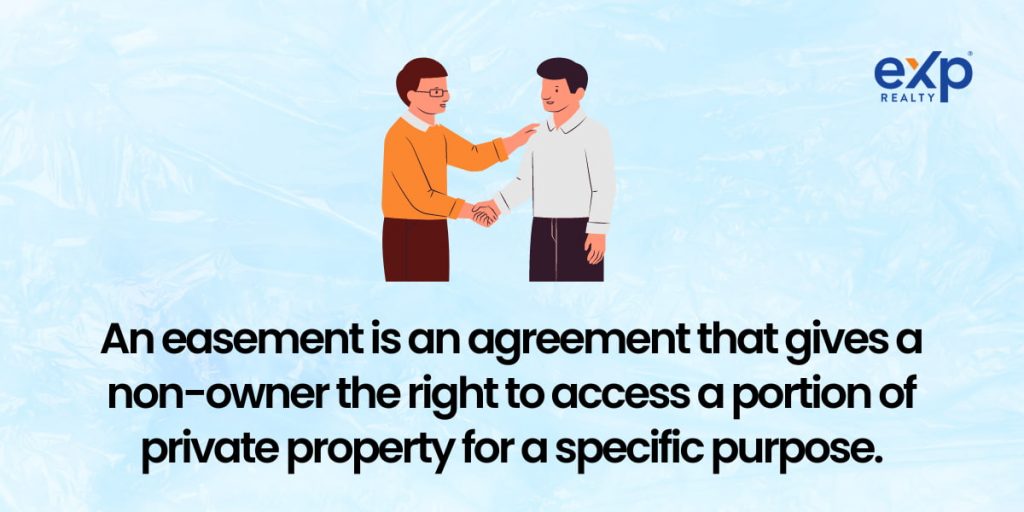If you’re about to buy or sell property, there’s a lot to consider. Your real estate agent can guide you through most concepts, but something like an easement may warrant further explanation.
You might be wondering, what is an easement? What does it mean, and does it give someone else rights to your property?
You must understand easements if you plan to buy or sell a home. Below we cover this somewhat confusing concept in detail.
What Is an Easement in Real Estate?

An easement is an agreement that gives a non-owner the right to access a portion of private property for a specific purpose. The non-owner could be a person, a company, or a government entity, and the reason they need to access the property varies.
For example, let’s say you’re interested in purchasing a home within a beachfront community. The home you’re considering is up against a public beach and has direct beach access, but the homes on the opposite side of the street are not.
A walkway runs along your property, leading to the beach, giving access to your neighbors. That walkway is a type of easement.
Easements can be negative or affirmative. An affirmative easement prevents you from blocking access to the easement owner. In our beach home example, you would be unable to block the walkway.
A negative easement prevents you from developing your property in a way that block’s the easement holder’s access to something like light or a view.
So, let’s say the same beach home is built so that the neighbors across the street can still see the beach. If there’s a negative easement, you may not be able to add-on to your home in any way that blocks your neighbor’s view.
To be clear, easements don’t grant ownership rights or direct property rights, but they can still affect how you use and develop your property. So, it’s crucial to understand them.
Should I Buy a Property with an Easement?
Easements are very common in real estate, and usually, potential buyers don’t have to worry about them. Often, they benefit the property owner and the surrounding community.
For example, an easement may allow an electric company to reach a power line or a water company to reach a pipe. It could also allow neighborhood kids to safely reach a school or community members to access a public park.
However, you’ll want to be aware of any easements before you purchase real estate. An easement could affect how you’re able to develop or use your property. And, sometimes easement issues can be extremely frustrating for owners.
Types of Easements
There are many kinds of easements, from the conservation easement meant to protect historic properties to the recreational easement, allowing the public to use undeveloped land. While we won’t cover every specific type of easement, we will cover the most common easements below.
First, though, it’s important to understand the difference between an appurtenant easement and a gross easement.
An easement appurtenant is between two properties. The easement appurtenant gives the dominant estate or easement holder access to the other property for a specific purpose.
Our beach home example shows an appurtenant easement. Easements like this are permanent and transfer with the property’s title. They may be implied, or a court may order an easement by necessity.

An easement by necessity is not created through an explicit agreement between neighbors, but rather it is established by law as a means of attaining equitable outcomes.
Gross easements grant access to your property for a specific entity. So, a utility company may have a gross easement that allows them to access equipment on your property.
As we discuss the common types of easements below, we’ll mention whether they’re appurtenant or gross.
Right-of-Way Easements
A right-of-way easement gives freedom to use a path or roadway on your property. This is a very common type of easement, especially in rural areas.
In areas where people own vast swaths of land and there are more private roads than public, you may have to cross through someone else’s land to access a piece of property.
You’ll find right-of-way easements in the suburbs, too, though. They’re often a public easement, allowing community members to access public land by cutting through private property.
For example, if your home backs up to an elementary school, a path on the edge of your property may allow neighborhood kids to safely access the school without crossing a public street. That path would be a right-of-way easement.
Right-of-way easements are almost always easement appurtenant, and you won’t be able to challenge them when you purchase real estate.
Utility Easements
A utility easement gives utility employees access to infrastructure located on private properties. These are common and necessary if you want your property and the surrounding community to have water, electricity, cable, and sewage.
For example, a power company may need access to your driveway to reach a power pole. Or, the water company may need access to a pipe beneath your yard.
Public utility easements are gross, meaning the employees only have access for a specific purpose, usually to monitor or repair equipment. However, they also have the right to update or install equipment that you may or may not like.
You can challenge utility easements when you purchase property, but you’re unlikely to win. Because these easements benefit your property and the community, the local government will likely hold onto them.
Prescriptive Easements
The law grants a prescriptive easement to someone with no property rights who has been using a portion of private property in a hostile or open way for a time defined by state law. In that sense, a prescriptive easement is similar to adverse possession rights or squatter’s rights, except there’s no ownership transfer.
Just like when squatters claim possession rights to a property, the nature of the possession matters in an easement by prescription. The dominant estate has to have been using the property for a prolonged period, and the servient estate can’t have attempted to stop the practice.
For example, let’s say you’re interested in a parcel of land along a lake. You discover a footpath cuts through the property. The neighbors have used this footpath to get to the lake for an extended period. They never received permission, but the current property owner didn’t attempt to stop them either.
Those neighbors could claim an implied prescriptive easement on the path to the lake. So, if you were to buy the property, you’d be unable to obstruct the path.
This is why, as a property owner, it’s so important to stop trespassing. If someone has been trespassing on your private land for a prolonged period, they can claim they have a prescriptive easement, which could be a problem if you try to develop or sell the property.
Private vs. Public Easements
Any of the above easement types could fall under the private or public domain, and it’s important to understand the difference.
A private easement grants land rights to specific people, usually for a particular purpose. For example, you might grant an easement to your neighbor to run a cable under your yard. You could give private easement freely, or you could sell the easement rights.

A public easement grants access to the general public. The local government enacts it and doesn’t require the property owner to agree. A right-of-way easement that gives children access to a public park or a utility easement is a good example.
Understanding Easements on Your Property
Most of the time, an easement isn’t a big deal. They are often neutral or beneficial to you as a property owner. However, you’ll still want to know if any exist on a plot of land before you purchase it!
To find out about any easements on your property, start with the seller disclosure documents, which your real estate agent should provide. If the seller knows of any easements, they must list them there.
However, if you’re the future owner of a large piece of land, undeveloped land, or property that the owner hasn’t occupied in a prolonged period, they may not be aware of an easement. So, you may need to dig through other legal documents. Consider consulting any and possibly all of the following:
- Local Assessor
- County Clerk
- Utility companies
- Real estate attorney
- Title company
You can also run a title search. Under the Torrens title system of land ownership registration, an express easement has to be recorded on title documents.
If you find an easement, it’s important to understand its extent. Legally, an easement holder has the right to do whatever is convenient or necessary to fully enjoy the purpose for which the easement was granted.
So, if your neighbor has a right-of-way easement on the road through your property, they have the legal rights to maintain that road. They may be able to pave it, cut back trees and brush, or make other developments to ensure they can use it.
More often than not, easements are permanent. However, you may be able to terminate them in certain situations. For example, if you can show evidence of misuse or abandonment, you may be able to get rid of an easement. However, you’ll need a real estate attorney to pursue easement termination.
Key Takeaways
So, what is an easement? Simply put, an easement gives non-owners the right to a portion of your property for a specific use. It doesn’t provide them with ownership rights; most of the time, easements benefit the community.
However, in some cases, an easement can cause a problem for a property owner. If you want to develop the property or add-on to an existing building, an easement could be troublesome. If that’s you, it’s best to seek legal advice from an attorney who understands real estate.
FAQs What is an easement: A homeowners guide
Below, we answer some of the most common questions regarding easements.
What is an easement in simple terms?
An easement describes an agreement between a property owner and some other person or entity that allows that person or entity to use the property without making any ownership claim.
How do easements work?
Easements allow a person, group of people, or entity to use or access a portion of your property. They come in several different forms.
Sometimes, the property owner allows for an easement because it benefits them (driveway easement) or the community (Historic Preservation easement.) Other times, a government entity requires an easement because it plays a vital function. And in some cases, an easement exists because someone has been using a portion of the property openly and for a long period.
Usually, once there’s an easement in place, it doesn’t go away, even when a property changes ownership.
What is the most common type of easement?
Most easements are affirmative, meaning they allow the use of land by non-owners. Kids using part of your property to access their school or a neighbor using part of your driveway to access the road would be affirmative easements.
Another, even commoner type of affirmative easement is a utility easement which allows a local utility to access equipment on private property.
What’s the difference between dominant estates and servient estates?
The land that is subject to an easement is known as the servient estate, or servient tenement, while the one that gains benefit from it is called the dominant estate, also known as dominant tenement.
Is an easement a legal right?
Yes, an easement gives the easement owner the legal right to use a property. It doesn’t give them ownership rights, but they are allowed to use and maintain the easement so that they can fully enjoy the purpose for which it was granted.
Can a property owner block an easement?
No, property owners cannot block or impair an easement. If an easement allows a neighbor to use your driveway, for example, you can’t put in a gate that would block their access. Doing so is illegal.
Can you build a fence on an easement?
No, you can’t build a fence on an easement. Building anything that impedes the easement owner’s ability to use the portion of your property they have a right to is illegal.
Who is responsible for maintaining an easement?
Easement holders are responsible for maintaining the easement. So, if you own a landlocked parcel and have a driveway easement on your neighbor’s land, it’s your responsibility to maintain that space. That may mean trimming the brush, paying for pavement repairs, or other maintenance costs.
How many years is an easement right?
In most cases, easements are perpetual. Unless an easement agreement states a specific period of time or there’s a specification that the easement may be challenged when property owners change, the easement will run with the land forever.
How do you prove easement rights?
Implied easements can exist. Easement rights are usually listed in the title papers. However, a legal easement can exist even if it’s not in writing.
If a person or entity has been using a portion of private property for a specific purpose for a long enough period, they may also qualify for an easement by prescription.
Can you build right next to the easement?
You can build next to an easement as long as you don’t interfere with the purpose of the easement. Depending on the easement, you can build over or under it.
How do I terminate an easement?
There are a few ways to terminate an easement. Almost all of them require legal action. With the help of an attorney versed in real estate law, you may be able to prove abandonment, misuse, or an end of necessity. Alternatively, the easement holder could willingly sign an agreement to end the easement.
When can you terminate an easement?
Technically, you can terminate an easement at any point if there’s a legally valid reason. However, most easements are perpetual, and you’ll need a good real estate attorney and ask them to take legal action if you’re attempting to dissolve one.





